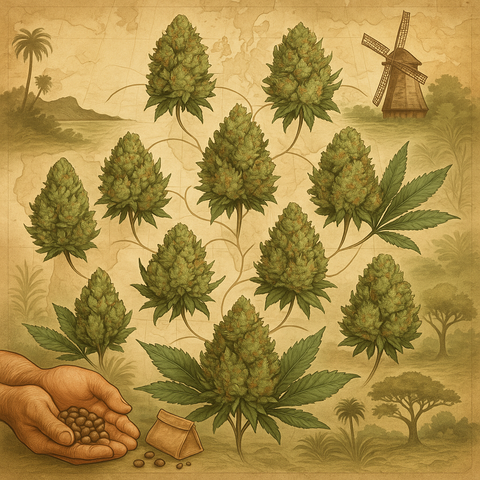
Cannabis has traveled a long path from regional landrace plants tended by small communities to the curated, globally traded varieties users consume today. Many strains carry origin stories that mix deliberate breeding, chance crosses, cultural movements, and the efforts of growers who kept seeds alive through prohibition and transition. The following 15 strains are among the most influential in modern cannabis culture. Each has a story of lineage, regional adaptation, breeder intent, and real-world impact on users, medicine, and the industry.
1. OG Kush
OG Kush occupies a mythic space in the modern cannabis canon. Its exact genesis is contested, which only adds to its legend. The most accepted narrative places its roots in Florida, where a grower obtained a strain called “Kush” and crossed it with a Chemdawg cut, then moved plants to California. Another interpretation of the name says OG stands for Ocean Grown, linking it to a Southern California grower scene that nurtured its rise in the 1990s. Whatever the precise path, what emerged was a plant with an unusual terpene profile combining earthiness, citrus, and pine with an unmistakable fuel-like funk that made it stand out in crowded markets.
What makes OG Kush foundational is not just its aroma or potency but its success as a parent. Breeders have used it to create countless offspring, injecting its heavy, calming high and distinctive scent into newer hybrids. Its psychoactive profile often includes a creeping body relaxation underpinned by a euphoric cerebral lift. That duality made it popular with both recreational users seeking a profound experience and medical users looking for anxiety relief without complete sedation. OG Kush’s cultural footprint extends beyond flower: its name is adopted in apparel, music, and the lexicon of cannabis enthusiasts. Far from a single lineage, OG Kush represents a nexus where breeding, regional culture, and potency expectations converged.
2. Blue Dream
Blue Dream began as a California creation intended to bridge therapeutic benefit and user-friendliness. Bred by crossing the indica-dominant Blueberry with the sativa Haze, the goal was to produce a plant that offered pain relief and mental clarity without the heavy sedation of pure indicas or jittery overdrive of straight sativas. California’s medical marijuana community embraced it, and the strain rode the wave of patient advocacy and legalization momentum to national recognition.
Its story also has a social dimension. As cannabis moved from counterculture into mainstream wellness conversations, Blue Dream became a default recommendation because of its approachable effect profile. It helped normalize the idea that cannabis could manage chronic pain, mood disorders, and fatigue while still allowing people to function and participate in daily life. Its genetic stability and predictable effects made it a favorite for commercial cultivation, and its sweet, berry aroma helped it travel well in dispensary branding.
Beyond its utility, Blue Dream has become a cultural touchstone. It consistently ranks high in popularity surveys across states with regulated markets. Growers praise its vigor, resilience, and yield. Consumers value the balance it strikes: a clear-headed buzz layered over gentle body ease, often described as “motivating without anxiety.” The lineage of Blue Dream has also shaped later breeding efforts, with many hybrids using it as a parent to retain that balance while introducing new flavors or targeted therapeutic profiles.
3. Girl Scout Cookies (GSC)
Girl Scout Cookies began as a regional sensation in Northern California, emerging from a small collective of breeders who were pushing potency boundaries while experimenting with flavor layering. Its core lineage is attributed to a cross of OG Kush and Durban Poison, but early phenotypic variations in those first runs produced phenotypes like Thin Mint and Platinum GSC that differed enough to become recognized separately. The name itself evokes a contrast between a familiar comfort and the potency of the product, and it helped the strain carry an approachable yet premium identity in underground markets before wider legalization.
The rise of GSC coincided with a broader shift in cannabis culture toward branding and connoisseurship. Consumers began to care not just about THC percentages but about aroma, mouthfeel, and the story behind the seed. GSC delivered on multiple fronts. Its flavor profile included a sweet minty finish layered over earth and gasoline notes. Its high was complex: an uplifting cerebral swell paired with a calming body sensation that could turn into couch ease if overconsumed. That layered effect made it popular both for creative tasks and for unwinding.
GSC’s influence extends through the breeding world. Its offspring and crosses—like Gelato and Wedding Cake—carry forward aspects of its profile, and its sale helped establish the idea of boutique phenotypes and limited batches. It also shaped consumer expectations around hybrid versatility, showing that a well-bred cross need not lean hard toward sativa or indica to be compelling. For many growers, securing a stable GSC phenotype became a badge of skill, and for many users, the strain remains a benchmark for potency and flavor sophistication.
4. Sour Diesel
Sour Diesel’s story begins in the underground network of East Coast growers in the early 1990s, though its precise parentage is debated. Common lore places it as a descendant of Chemdawg 91 with possible contributions from Super Skunk or other skunky, pungent lines. It first gained traction among medical patients and creative professionals for its fast-acting, energizing cerebral high that did not dull cognition. The name reflects its dominant scent—a sharp, fuel-like aroma with citrusy and pungent sour notes that announced its arrival before the first puff.
The strain became symbolic of a particular kind of sativa experience: one that could power long work sessions, idea generation, and social clarity without grounding the user in lethargy. Its popularity grew along with the rise of the “head high” appreciation, especially in regions where indica-heavy strains dominated until then. Sour Diesel’s genetics continued to circulate in breeding circles, influencing new sativa-dominant hybrids and contributing to the push toward cleaner, more cerebral effects.
Culturally, Sour Diesel appeared in music and media as a shorthand for elevated energy and focus. It also became a flagship strain for dispensaries, often used to signal a quality selection of sativas. Its resilience in breeding, combined with a consistent effect profile, allowed it to become both a cultivar on its own and a building block for later varieties. For users seeking anxiety reduction while staying engaged, Sour Diesel played a significant role in broadening the appeal of cannabis beyond purely recreational narratives.
5. White Widow
White Widow was first introduced in the mid-1990s in the Netherlands, a country that at the time was a global hub for experimental cannabis breeding due to its progressive tolerance policies. Created by crossing a Brazilian sativa landrace with a South Indian indica, the strain delivered a hybrid that combined trichome density, potency, and balanced effects. It stood out in Dutch coffee shops because its buds sparkled with resin, earning the “white” descriptor in its name, while its effects wove together cerebral uplift with gentle physical ease.
Its ascent was tied to the emergence of the global cannabis tourist. Many visitors to Amsterdam encountered White Widow and brought seeds, cuttings, or inspiration back to their home countries, accelerating its spread. It also exemplified a shift in breeder focus from purely psychoactive strength to complex, layered experiences: not just “hard hitting” but “multi-dimensional.” White Widow’s genetic stability made it a breeder favorite, and it became the progenitor of dozens of subsequent hybrids.
In the cultural narrative, White Widow represented a bridge between the old world of landrace reverence and the new world of designer hybrids. Its popularity helped establish the Netherlands as the place where cannabis could be refined into artful, consistent products. It also helped define modern expectations around “balanced” strain experiences, showing that a hybrid could meaningfully deliver both mental clarity and physical comfort. White Widow remains a touchstone for growers and users who want a reliable and nuanced experience.
6. Amnesia Haze
Amnesia Haze traces its roots to a complex collection of genetics from several continents. Developed in the Netherlands in the early 2000s, breeders crossed various Haze lineage plants with landrace varieties from Southeast Asia and the Caribbean, including Thai and Jamaican sativas. The goal was to intensify the cerebral, euphoric characteristics of original Haze while stabilizing the sometimes unwieldy growth patterns and long flowering times associated with haze genetics. The result was a strain that delivered a high so vivid and expansive that early users described temporary lapses in short-term recall, hence the name “Amnesia.”
Its rise in reputation was driven by awards and the identity of Amsterdam as a global cannabis hub. Amnesia Haze won multiple cannabis cup competitions, garnering attention from connoisseurs and commercial producers alike. Its aroma is a layered bouquet of citrus zest, earth, and spice with a floral lift that hints at its tropical ancestry. The effect profile is a rapid onset of a bright, energetic head high carrying both creativity and an almost euphoric clarity, often followed by a soft physical settle that does not overpower.
Amnesia Haze also impacted medical usage by demonstrating that powerful sativa effects could be tuned for therapeutic application, especially for patients dealing with depression or chronic fatigue who needed motivation without sedation. Its influence shows up in many modern “haze-influenced” hybrids that seek to capture that same high-energy, uplifting mental state while trimming cultivation complexity.
7. Jack Herer
Jack Herer is both a strain and a tribute. Named after the author and activist who spent his life advocating for cannabis normalization, the strain was developed in the 1990s by Dutch breeders at Sensi Seeds. It is a thoughtful hybrid that crosses a Haze hybrid with Northern Lights #5 and Shiva Skunk. The intent was to create something inspirational: a mental high that sparked clarity, productivity, and mood elevation while maintaining enough grounding from indica heritage to prevent overwhelming jitteriness.
The strain carries the legacy of its namesake, embodying a cerebral lift that many users describe as “transparent” or “focused.” Its terpenes give it a distinct pine and citrus fragrance with subtle spicy accents. The story of Jack Herer the person—who authored “The Emperor Wears No Clothes” and argued for factual, science-based decriminalization—augments the strain’s cultural power. When consumers choose Jack Herer flower, they often do so with awareness of that context, seeing the high as both a physical experience and a small nod to activism and knowledge.
Jack Herer also served a practical role in bridging user preferences. It showed that the divide between sativa and indica could be crossed elegantly: uplifting without anxiety, restful without dullness. The strain has been used in breeding to retain clarity while adding new flavor or resilience traits, and its name remains a powerful brand in the cannabis world because it ties potency to purpose.
8. Pineapple Express
Pineapple Express entered the wider cultural awareness through the 2008 comedy film, but its origin precedes the movie. It is a cross between Trainwreck and Hawaiian. Trainwreck contributed a fast-acting, potent cerebral element while Hawaiian added a bright tropical sweetness and lifted mood. The film’s usage amplified its appeal, collapsing the gap between underground reputation and mainstream familiarity. The strain became associated not just with its flavor but with a kind of accessible, day-friendly experience: energetic yet smooth, fruity yet grounded.
Growers favored Pineapple Express because it retained good yields while showcasing a signature aroma that was immediately identifiable: sweet pineapple, citrus, and a subtle skunk warmth. Users gravitated toward its ability to provide creative stimulation, social ease, and mild body comfort without dragging the day down. That balance made it a candidate for both recreational and functional use, whether for weekend outings or creative afternoon sessions.
Pineapple Express’s narrative also reflects how media can influence cannabis popularity. The film gave the strain a story hook, and consumers who might not have otherwise tried it were curious. Breeders leveraged that recognition to experiment with crosses that retained the tropical notes while emphasizing resilience or potency. Over time it became a template for “flavor-forward” hybrids, showing that complex aromatic profiles could coexist with user-friendly effects.
9. Candy Kush
Candy Kush is the product of intentional flavor-driven breeding. It combines OG Kush genetics with elements of sweet dessert-type profiles, in some lines crossing back into fruitier parents to heighten candy-like aroma and taste. The goal was to merge the heavy, calming physical presence of Kush with a sugar-sweet scent that felt indulgent and approachable. Candy Kush rose in popularity in dispensaries where consumers were seeking both potency and a memorable sensory experience.
The story of Candy Kush includes the trend toward experiential cannabis: not only how the plant affects mood or pain but how it smells, tastes, and fits into a ritual. Its aroma resembles a mix of sugary treats, with vanilla or caramel undertones, layered over classic earthiness. Its high often begins with a pleasant euphoria that settles into physical ease, making it a favorite for evening unwinding or treating stress without losing a sense of happiness.
Breeders have used Candy Kush as a model for dessert strains, helping establish a subgenre where terpene-forward profiles are marketed alongside well-defined effects. It has also been embraced in medical communities for anxiety and mild pain because of its relaxing yet mood-lifting combination. Its legacy is less about a singular lineage and more about the shift toward “luxury” cannabis that feels both effective and sensory-rich.
10. Durban Poison
Durban Poison is a pure sativa landrace strain originating in the port city of Durban in South Africa. Unlike many modern hybrids, it carries direct lineage from its native region, cultivated for generations in a relatively stable environment before being transported globally. Its preservation was due to growers who valued its resilience, clear-headed effects, and ability to flower relatively quickly for a sativa. It arrived in the global breeding scene as a benchmark for pure, energetic sativa character.
The strain’s history includes its use in early breeding programs to inject vigor, clarity, and tropical sweetness into hybrids. Durban Poison’s terpenes produce a sharp licorice or anise aroma with underlying sweet and earthy layers, and its psychoactive profile delivers sustained focus, creativity, and uplift without heavy sedation. It became popular among artists, professionals, and daytime users who wanted a mental edge.
Durban Poison also carries cultural weight as a preserved landrace. In an era where many original genetics were diluted by widespread hybridization, Durban Poison stood as an example of a strain maintaining its identity. It is often used now in crosses to lighten indica heaviness or to restore sativa brightness in more muted hybrids. Its story is one of survival, clarity, and the value of keeping pure genetics alive amid a flood of designer crosses.
11. Gelato
Gelato is a celebrity heir to the Girl Scout Cookies lineage, bred in California by the Cookie Fam and first cultivated out of the Bay Area. It is a cross of Sunset Sherbet and Thin Mint GSC, and it was engineered to offer a creamy, dessert-like flavor with an elevated high that blended body ease and mental clarity. Gelato’s intense terpene profile, including sweet citrus, berry, and creamy pastry notes, quickly made it a favorite among connoisseurs and creators of high-end cannabis products.
Its story is also a story of refinement. Gelato did not just ride the coattails of its parents; it enhanced and amplified their desirable traits. Its genetics produced flower with rich color, dense trichomes, and a balanced high: a euphoric cerebral lift followed by a soft relaxation that did not drag into sedation. High-end extract makers and boutique cultivators gravitated toward it because it translated well into concentrates, vapes, and curated flower collections.
Gelato’s influence is visible in the proliferation of “Gelato-style” hybrids that seek that signature combination of flavor and layered effect. It also helped cement the idea that a strain could have a luxury branding position, commanding premium price points and limited releases while still being used therapeutically for stress and pain management.
12. Granddaddy Purple
Granddaddy Purple, often abbreviated GDP, was developed in California by breeder Ken Estes as a cross between Purple Urkle and Big Bud. The intent was to create an indica-heavy strain that delivered deep relaxation with a visually striking appearance. The deep purple hues in its buds and its thick resin coating quickly turned it into an icon of evening and recovery use.
Its story has a strong medical thread. Patients coping with insomnia, chronic pain, and muscle tension found reliable relief in GDP’s sedative effects. The strain’s berry-sweet aroma and grape-like flavor provided a comforting sensory backdrop to its heavy body high. Artists and storytellers in the community often reference GDP as a go-to “reset” strain after long days or physical strain.
Beyond its immediate effects, Granddaddy Purple helped bolster the visibility of heirloom indica genetics in a market increasingly preoccupied with high THC numbers. It reminded users and growers that coloration, mouthfeel, and a sustained calming effect could be differentiators in their own right. GDP’s legacy continues in breeders returning to its lineage to recapture its combination of appearance, flavor, and deep restfulness.
13. Northern Lights
Northern Lights is shrouded in partial mystery, likely bred in the Pacific Northwest, with roots tied to Afghani and Thai landrace genetics. It emerged as a foundational indica in the 1980s and 1990s, revered for its rapid flowering, high resin production, and reliable, heavy relaxation. The strain became one of the first to gain widespread acclaim in both underground and early legal markets for its potency and ease of cultivation.
Its impact goes beyond effect. Northern Lights helped shift grower expectations around the viability of indica-dominant strains for therapeutic use. Its high is characterized by a deep body calm that can ease tension while offering a mild cerebral softening; for many users it became the strain to reach for when sleep was elusive or anxiety persistent. The smell is a fusion of sweet pine and earthy herbal notes, comforting and familiar.
Northern Lights also helped establish breeding lineages. Its genetics appear in countless offspring, where its stability is used to anchor more experimental profiles. As legalization spread, it became a reference point for classic indica experience, often used in dispensary education to explain contrast with more energizing sativas. Its resilience in cultivation and balanced effect profile help it remain a staple decades after its introduction.
14. Bubba Kush
Bubba Kush’s lineage is less formally documented but is believed to originate from a cross involving OG Kush and an unknown indica, resulting in a strain with a heavy sedative profile and a distinctive earthy, coffee-like aroma. The strain surfaced in the 1990s, primarily on the West Coast, and quickly gained reputation for its ability to deliver deep physical relaxation with a calm, pleasant mental state. It was embraced by users seeking escape from chronic pain, stress, and insomnia.
The name Bubba evokes comfort and reliability, which aligns with how users describe its effects: dense, weighty, and softening. Its flavor profile includes notes of chocolate, coffee, and peppered earth, carried on a thick smoke that often results in couch-bound ease. The strain’s potency and flavor made it a staple for evening or recovery sessions, and its genetics have been used to create other indica-dominant crosses that aim for the same heavy lift with a forgiving onset.
In the breeder community, Bubba Kush became a go-to for adding depth and weight to blends without creating disorientation. Its legacy is in the way it showed how indica influence could be refined into a clean, strong, and predictable experience rather than a muddy heavy fog.
15. Skywalker OG
Skywalker OG blends two heavy hitters: Skywalker and OG Kush. It originated in California as breeders sought a strain that combined the relaxing heaviness of OG Kush with the slightly more uplifting and balanced effects of Skywalker. The resulting hybrid delivers a pronounced body calm layered over a thoughtful, slightly cerebral presence, making it popular for both stress relief and nighttime use.
Its aroma is pungent with earth and diesel notes, softened by herbal sweetness and pine. The name evokes a cultural nod to science fiction and expansive thinking, which matches the strain’s ability to quiet physical tension while keeping the mind open enough to reflect or unwind emotionally. Users often describe it as a “full spectrum” relaxation experience where physical relief is accompanied by gentle mental clarity, avoiding complete sedation while still offering rest.
Skywalker OG has become a tool for medical users treating anxiety, muscle spasms, and insomnia, and for recreational users seeking a reliable evening companion. Its genetics are used in newer crosses where breeders want to retain that balance of weight and wakefulness. The strain’s story is one of synthesis: combining legacy lines to produce a hybrid that feels both familiar and distinct.
That's a Wrap
The top 15 cannabis strains above are more than their cannabinoid profiles. They are the product of geography, cultivation ingenuity, naming that carries cultural resonance, and consumer demand for specific effects. Whether through landrace preservation, experimental hybridization, or cultural amplification, each strain has a lineage that reflects part of the industry’s evolution. Understanding their origins and stories adds depth to the user experience and highlights the craftsmanship behind modern cannabis breeding.


